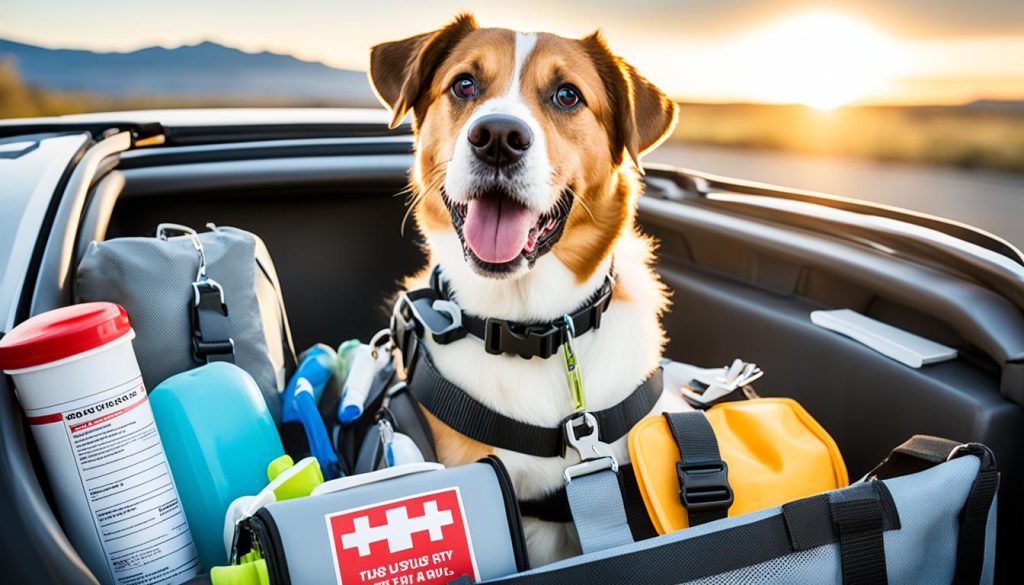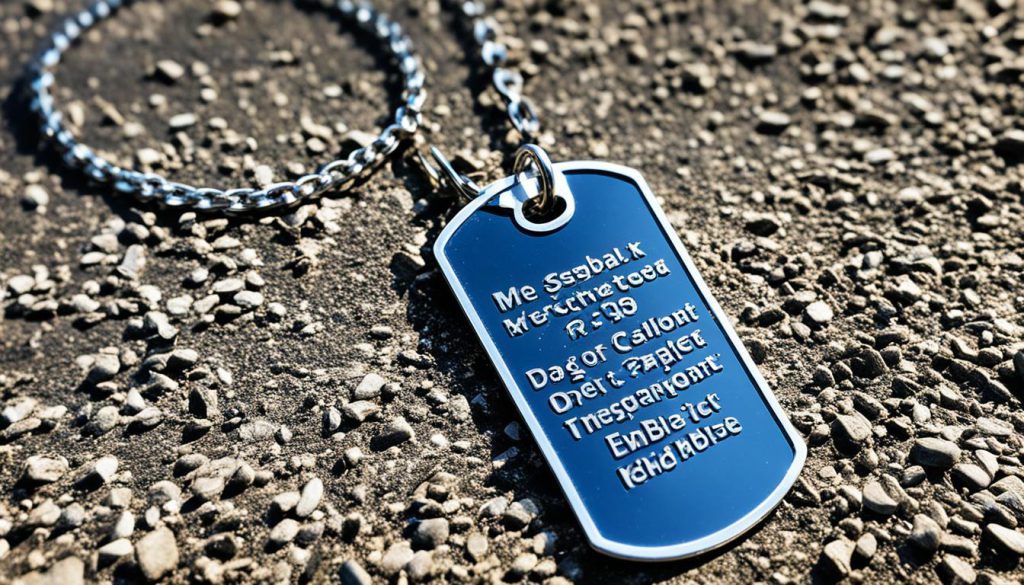A few months ago, I took my dachshund, Max, on a road trip. We saw beautiful national parks and quaint towns. Yet, traveling with a dog comes with challenges. Trips to the vet and making sure vaccinations are current can be tough. But seeing Max enjoy new places was all worth it.
When prepping for travel with pets, know airline rules. Airlines require health certificates for dogs. Dog crates are needed for flights, and Amtrak allows dogs under 20 pounds for a $25 fee. Every airline has its own pet travel rules, needing health docs not older than ten days. This makes travel smoother and more fun.
Finding places to stay with Max needed effort. Many hotels and motels have rules about dog sizes or don’t allow them. Some cruise lines let dogs on board, but it varies. Understanding these details is key for a smooth trip with your dog.
Traveling with dogs is rewarding but needs planning. Making sure Max was comfortable and finding pet-friendly spots was key. Our trip was memorable thanks to thorough preparations. It made our journey enjoyable for both of us.
Complete Guide to Traveling with Your Dog
Key Takeaways
- Pre-trip veterinary visits ensure your dog’s health and vaccination status are up to date.
- Each airline has unique regulations for pet travel; securing a health certification is essential.
- Only small dogs (under 20 pounds) are allowed on Amtrak trains, with a $25 fee.
- Finding pet-friendly lodging requires comprehensive research due to potential size restrictions.
- Preparation and familiarization with travel settings enhance the experience for both you and your dog.
Planning Your Trip: Things to Consider
Traveling with pets needs careful planning. This means looking at dog-friendly places and getting your dog travel-ready. Let’s look at the important parts of planning your trip.
Research Dog-Friendly Destinations
First, find out about dog-friendly destinations. There are many pet travel guides with lists of parks, restaurants, and places that allow dogs. Also, check the airline’s policies. Some have limits on pets and need health certificates for dogs. These certificates should be dated no more than 10 days before flying.
Prepare Your Dog for Travel
Getting your dog ready involves both physical and mental prep. Get your dog used to different places and ways to travel. Make sure they can eat and drink their usual stuff. Dogs flying need to be at least 8 weeks old and weaned.
For train trips, Amtrak lets dogs under 20 pounds travel for a $25 fee. But, Greyhound buses and other buses don’t allow pets. The only exception is for service dogs.
Make Copies of Important Documents
It’s key to have all your dog’s documents when traveling. Carry copies of your dog’s health records and vaccination info. Make sure your dog has ID on their collar. Think about getting a microchip for extra safety.
| Travel Method | Requirements |
|---|---|
| Airlines | Health certification within 10 days, dogs must be 8 weeks old, some airlines limit pet numbers |
| Amtrak | Allows dogs under 20 pounds for a $25 fee |
| Interstate Buses | Typically no dogs allowed except service animals |
| Hotels | Possible size restrictions on pets, some hotels do not allow dogs |
With these dog travel tips, you and your pet can have a great trip. Planning with tips for traveling with your dog helps make your journey memorable.
Health and Safety Preparations
Ensuring your dog’s health and safety during travel requires careful steps and planning ahead. It’s important to visit the vet, pack medical supplies, and have emergency contacts ready.

Visit the Veterinarian
Visiting your veterinarian before a trip is key. It ensures your dog’s vaccinations are current and health issues are checked. Airlines might need a health certificate within 10 days of your trip. Be cautious when traveling with breeds like bulldogs and pugs, as they have breathing challenges.
Pack Your Dog’s Health Essentials
Packing a travel kit for your dog’s health is crucial. Include medication, vaccination records, and ID tags. Add a recent photo of your pet in case they get lost. Get your dog used to their carrier well before your trip.
To lessen anxiety, don’t feed your dog 4-6 hours before traveling. Offer only small amounts of water to lower the risk of motion sickness and make the journey smoother.
Emergency Contacts and Plans
It’s vital to have an emergency plan when traveling with your dog. Find veterinary services at your destination ahead of time. Ensure your pet’s collar won’t catch on carrier doors and it has clear ID. Report any mistreatment immediately to authorities.
For comfort, avoid extreme temperatures by choosing flights wisely. Consider less busy times for shipping pets to avoid rough handling. Staying informed and prepared makes dog travel safer and more enjoyable for both of you. Always prioritize health and safety measures for your dog.
Choosing the Right Dog Travel Crate
When planning a trip, it’s crucial to pick a safe, comfortable travel crate for your dog. It must also meet airline rules.
Features of a Good Travel Crate
A quality travel crate offers enough air flow, is sturdy, and fits your dog well. It should let your dog stand, see outside, turn, and lie down easily. There are standard kennel sizes, like the small #100 Series to the large #700 Series. For big dogs, custom crates fitting IATA standards may be needed. It’s important to choose a slightly larger size when in doubt.
| Crate Feature | Details |
|---|---|
| Ventilation | Ensures fresh air circulation for the pet |
| Durability | Hard-sided carriers favored for larger dogs traveling in cargo |
| Proper Size | Allows the pet to stand, turn, and lie down comfortably |
| Compliance | Adheres to airline regulations for size and construction |
Crate Training Tips
Training your dog to like the crate reduces travel stress. Start by lining it with treats. Increase crate time gradually, linking it to fun.
Before a big trip, get your pet used to long periods in it. Properly label and secure the crate for air travel is key to your pet’s safety. Planning helps you and your pet travel better.
Dog Identification and Safety
Making sure your dog has proper identification is crucial. Sadly, about 30% of pets don’t have microchips. This shows how vital it is to use microchips for dependable ID. Also, just 20% of pet owners use collars and tags with their info. This is key for pet travel safety.

Get a strong leash and a collar with clear, updated tags. Having a recent photo of your dog helps too. It makes identifying and returning your pet faster if they get lost. Don’t forget to carry updated health records. This is important for dog travel tips, especially when you need to show vaccine proof.
| Travel Mode | Identification Needs | Safety Considerations | Benefits |
|---|---|---|---|
| Car | Collar with Tags, Microchip | Well-ventilated Crate | Comfort and Security |
| Airplane | Microchip, Health Certificates | Temperature Control | Required for Travel Compliance |
| Train | Collar with Tags | Weight Restrictions | Pet-Friendly Routes in Europe |
Microchipping your pet greatly improves pet travel safety. It’s surprising that 30% of pets still don’t have one. This tech increases the chance of finding your dog if they get lost. Remember, a collar with tags is also very important.
Using thorough dog identification methods boosts your pet’s safety. This includes a good leash, current tags, and a microchip. For extra safety, carry a recent photo and duplicated health records. These dog travel tips help make your journey safe and fun.
Traveling By Car With Your Dog
Taking your dog on a car trip can be fun if you make sure they’re safe and comfy. Here are tips to make the journey great for you and your furry friend.
Car Safety Measures
Keeping your dog safe in the car is crucial, whether on long drives or short trips. Nearly all pet owners have taken their pet on a trip. It’s essential to use dog seat belts or secure carriers in the back seat.
Pets should not roam free in the car. They can distract the driver and are at risk if you stop suddenly.
Keep your dog away from the front seat to prevent injury from airbags. Follow federal rules for transporting pets. Make sure there’s enough fresh air in the car, too.
Keeping Your Dog Comfortable
To keep your dog comfy, let in fresh air but don’t let them stick their head out. Use cozy bedding and keep the car at a good temperature. Vets say not to feed pets right before traveling to avoid sickness.
Getting your dog used to the car by taking short trips can help. This reduces their stress and makes them better travelers.
Essential Stops During Road Trips
When you’re on a road trip, stopping every few hours is key. It lets your dog walk, drink water, and go potty. This is especially important in the summer for pets like bulldogs.
Never leave your dog in a hot car, even with the windows down. Car interiors can become very hot quickly. Stopping helps keep your dog healthy and happy.
By following these tips, you and your dog will have a pleasant travel experience together.
Dog Travel Tips for Air Travel
Flying with dogs can be rewarding yet challenging. Statistics show 60% of dog owners take their pets on vacation. It’s crucial to know airline-specific requirements and follow these dog air travel tips.
Start by understanding health regulations. About 30% of pet owners focus on health and safety while traveling. Airlines require a health certificate issued within ten days before flying. Also, brachycephalic breeds like bulldogs or pugs face more risks due to their short nasal passages. So, it’s best not to put them in the cargo hold.
Make sure dogs are at least eight weeks old and weaned before flying. Airlines set this age rule to ensure your pet is ready for the trip.
A reliable dog crate is vital; 40% of pet owners agree it’s key for safe travel. Select a durable, airy crate that fits airline standards. Get your dog used to their carrier a month before travel. This reduces their stress and makes the trip smoother.
Choosing direct flights is crucial. They lessen the chance of problems during transfers. If your pet must fly in cargo, direct flights are safer and reduce risks.
Don’t feed your pet 4-6 hours before traveling, but let them drink a little water. This helps avoid motion sickness and discomfort. Bring a recent pet photo and report any airport mistreatment you see. Speaking out can improve how animals are treated.
| Key Considerations | Importance |
|---|---|
| Health Certificate | Most airlines require it within 10 days of travel |
| Crate Familiarization | Allow pets a month to get used to the carrier |
| Direct Flights | Minimizes handling during transfers |
| Feeding | Avoid feeding pets 4-6 hours before travel |
By staying informed and following these dog air travel tips, your dog’s flight can be safe and comfy. Whether it’s about the right crate, health checks, or picking the best flight, good preparation and attention are the keys to a successful pet-friendly travel.
Navigating Dog-Friendly Hotels and Lodging
Finding a place where your dog is welcome can make traveling better. There are many choices, from simple motels to fancy hotels. The key is to find spots that like dogs. It’s also important to be polite guests.
Choosing the Right Accommodation
Doing your homework is vital when you’re traveling with your dog. Start by looking up dog-friendly hotels that match your budget and needs. These places might have special things like dog beds to make your pet comfy. But, always say if you have a big dog because some places have rules about size. Also, check if there are any pet fees.
Hotel Etiquette with Dogs
Good manners are important for a nice stay. Don’t leave your dog alone in the room. They could get noisy or wreck stuff. Your dog should be potty trained and not have fleas. This keeps things nice for everyone else. Bring your dog’s bowls so you don’t have to use things like ice buckets.
Stopping your dog from barking a lot helps everyone enjoy their stay. And always follow the hotel’s rules. Don’t try to bring your dog into places where they aren’t allowed. This could cause uncomfortable problems.
| Tip | Details |
|---|---|
| Don’t leave dog alone | Prevents damage and barking |
| Ensure housetrained | Maintains a clean environment |
| Bring flea-free dogs | Prevents discomfort for others |
| Bring own bowls | Avoids using unsanitary ice buckets |
| Prevent barking | Avoids disturbing other guests |
| Be upfront about size | Prevents any booking issues |
By picking the right places and following these tips, traveling with your dog can be fun and easy.
Top Tips for Traveling with Dogs by Train, Bus, or Boat
When you’re traveling with dogs, knowing the rules for different transport is key. Trains, buses, and boats all have their own set of rules. These can greatly affect your travel plans with pets.
Starting with trains, Amtrak allows dogs under 20 pounds for a $25 fee. But, only some trains let pets on, with service dogs being the exception. Always check with Amtrak to make sure your dog can come with you.
Buses tend to be stricter. For example, Greyhound buses do not allow pets, except for service dogs. You’ll need to look for other ways to travel with your pet on long bus rides.
Boats, especially luxury cruises like QE2, might have special services for dogs. But not all cruises are pet-friendly. Always check if your cruise offers these services. And remember, going abroad with your pet may require a quarantine period depending on the country.
Here are some tips for traveling with your dog to make the journey smooth:
- Look into the transport policies ahead of time.
- Make sure your dog is comfy in different travel crates. The crate needs to be big enough for them to stand, turn, and lay down.
- Bring all needed paperwork, like rabies and vaccine records. If you’re flying, you also need a health certificate from within 10 days of travel.
- Find out if your dog can stay with you in the passenger area. Sometimes, this is allowed if the crate doesn’t fit elsewhere.
- Book everything early to avoid last-minute issues.
Being well-prepared makes traveling with dogs fun and worry-free. Planning ahead and following the rules for each transport type helps create a great trip for you and your pet.
Conclusion
Traveling with dogs is rewarding but needs careful planning. Early steps include finding pet-friendly spots and preparing important paperwork. A visit to the vet and carrying health supplies are key for your dog’s well-being.
Air travel has specific requirements. 67% of airlines ask for a health certificate for pets. Also, 82% have strict rules about pet carriers. Since most pet owners choose to drive for long trips, getting your dog comfortable in a car is essential. This can be done through short, happy drives. Remember to pack all necessities and consider using things that reduce stress.
Health and safety are crucial. Almost all places need pets to be vaccinated or tested before they enter. Furthermore, nearly half of the pet owners see the benefit in pet travel insurance. Consulting with a vet is wise, especially to decide if your pet should travel. By applying these dog travel tips, your trip can be safe and fun.
To enjoy traveling with your dog, understanding each part of the trip is vital. This includes choosing dog-friendly places to stay and knowing how to travel with pets. With the right preparation and care, you and your dog can have great adventures together.
Source Links
- https://www.akc.org/expert-advice/travel/complete-guide-to-traveling-with-your-dog/
- https://www.humanesociety.org/resources/travel-safely-your-pet-car-airplane-ship-or-train
- https://www.webmd.com/pets/dogs/how-to-travel-with-your-dog
- https://www.petrelocation.com/learn/pet-travel-crates
- https://www.akc.org/expert-advice/lifestyle/best-dog-carrier/
- https://www.aspca.org/pet-care/general-pet-care/travel-safety-tips
- https://www.akc.org/public-education/resources/general-tips-information/travel/
- https://www.petfinder.com/dogs-and-puppies/training/socializing/tips-dogs-hotels/
- https://bettervet.com/resources/pet-safety/traveling-with-pets

